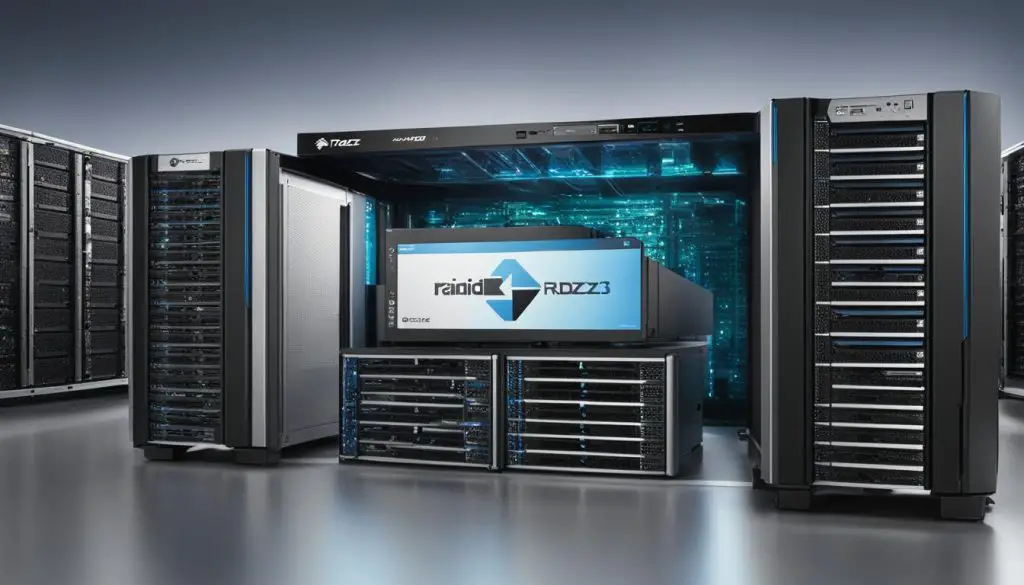Understanding RAIDz3 in ZFS Explained
Welcome to the world of ZFS and its powerful storage features. In this article, I will guide you through the concept of RAIDz3 in ZFS, its benefits, configuration, and much more. If you’re looking for a data protection solution with high levels of redundancy and fault tolerance, RAIDz3 is the ideal choice for you.
ZFS, known for its advanced file system and volume management capabilities, offers RAIDz3 as a specific RAID level to ensure the integrity and safety of your critical data. RAIDz3 is designed to withstand the failure of up to three drives within a storage pool, providing exceptional data recovery capabilities and preventing data loss.
When it comes to data protection, RAIDz3 in ZFS offers unmatched reliability. Its triple-parity protection ensures that your data remains intact, even in the face of multiple drive failures. This makes RAIDz3 a perfect storage solution for environments that require high levels of resilience and dependability.
Key Takeaways
- RAIDz3 in ZFS is a robust data protection feature that provides unparalleled storage redundancy and fault tolerance.
- It can withstand the failure of up to three drives within a storage pool, preventing data loss and enabling data recovery.
- RAIDz3 is an ideal storage solution for environments that require high levels of reliability and resilience.
- Understanding the structure of ZFS is essential to fully comprehend RAIDz3’s capabilities.
- Configuring RAIDz3 in ZFS involves careful planning, including vdev allocation and drive selection.
Understanding the Structure of ZFS
To fully comprehend the power and capabilities of RAIDz3 in ZFS, it is important to first understand the underlying structure of the ZFS file system. ZFS combines the traditional volume management and filesystem layers, offering a unique and efficient approach to data storage.
ZFS Structure Components:
- Zpool: The zpool is the highest-level structure in ZFS, serving as a container for all the data. It consists of one or more vdevs.
- Vdev: A vdev or virtual device is a fundamental building block of a zpool. It can be a single device or a group of devices, combining them into a logical unit. Vdevs can be used for plain storage or specialized purposes such as CACHE, LOG, or SPECIAL vdevs.
- Device: A device is a physical disk or any other block device that is part of a vdev. It contributes to the storage capacity and performance of the zpool.
- Datasets: ZFS organizes data into datasets, which are similar to directories or folders. Datasets can be created within a zpool and provide a logical separation for different types of data or projects.
- Blocks: ZFS divides data into fixed-size blocks for efficient storage and retrieval. Each block is uniquely identified and can be independently read or written.
- Sectors: Sectors are the smallest units of data storage on a disk. ZFS can use variable-sized sectors to optimize storage efficiency.
The structure of ZFS ensures the efficient utilization of storage resources while providing robust data protection and flexible management capabilities. By combining these components, ZFS delivers exceptional performance, reliability, and scalability.
Exploring RAID Levels in ZFS
ZFS offers a variety of RAID levels, each with its own set of unique characteristics. These RAID levels determine the level of data protection and redundancy provided by ZFS. Let’s take a closer look at the different RAID levels available in ZFS:
RAIDz1 in ZFS
RAIDz1 in ZFS is equivalent to RAID5 in traditional RAID systems. It uses single-parity blocks, allowing it to withstand the failure of one drive within a storage pool. This level of data protection provides an added layer of security against drive failures.
RAIDz2 in ZFS
In ZFS, RAIDz2 is similar to RAID6 in traditional RAID systems. It uses double-parity blocks, which enables it to tolerate the failure of up to two drives within a storage pool. RAIDz2 offers enhanced data protection and redundancy, providing an additional layer of fault tolerance.
RAIDz3 in ZFS
RAIDz3 is specific to ZFS and employs triple-parity blocks. This level of redundancy allows RAIDz3 to survive the failure of up to three drives within a storage pool. With RAIDz3, ZFS ensures maximum data protection and fault tolerance, making it a robust storage solution for critical data environments.
ZFS also supports mirror vdevs, which offer maximum data redundancy. Each block is stored on all devices within the vdev, providing an additional layer of data protection. However, it’s important to note that single-device vdevs in ZFS are inherently risky as they cannot survive any drive failure.
Understanding the various RAID levels in ZFS enables organizations to select the most suitable data protection strategy for their storage needs. By implementing the appropriate RAID level, businesses can ensure the integrity and availability of their data while minimizing the risk of data loss.
Benefits of RAIDz3 in ZFS
RAIDz3 in ZFS offers numerous benefits for data protection and storage reliability. By providing triple-parity protection, RAIDz3 ensures high fault tolerance and robust data integrity. It can withstand the simultaneous failure of up to three drives within a storage pool, minimizing the risk of data loss. This level of redundancy is particularly crucial for critical data and environments that require maximum storage reliability.
Additionally, RAIDz3 offers competitive performance, leveraging the distributed nature of ZFS write distribution. It balances the utilization of vdevs and optimizes throughput, enhancing storage efficiency and performance.
Here are the key benefits of RAIDz3 in ZFS:
- High Fault Tolerance: RAIDz3’s triple-parity protection enables it to withstand the failure of up to three drives, ensuring that data remains accessible even during multiple drive failures.
- Robust Data Integrity: By storing redundant data across multiple drives, RAIDz3 enhances data integrity and minimizes the risk of data corruption or loss.
- Maximum Storage Reliability: RAIDz3’s fault tolerance and data protection capabilities make it an ideal choice for environments that require reliable and resilient storage solutions.
- Competitive Performance: RAIDz3 optimizes storage performance by effectively distributing writes across multiple drives, enhancing throughput and efficiency.
Overall, RAIDz3 in ZFS combines strong data protection with solid storage performance, making it a powerful solution for organizations looking to ensure the safety and reliability of their critical data.
RAIDz3 vs Other RAID Levels
| RAID Level | Fault Tolerance | Data Protection | Performance |
|---|---|---|---|
| RAIDz3 | Up to 3 drive failures | Triple-parity protection | Competitive performance |
| RAIDz2 | Up to 2 drive failures | Double-parity protection | Good performance |
| RAIDz1 | 1 drive failure | Single-parity protection | Decent performance |
| Mirror vdev | Depends on mirror configuration | Maximum data redundancy | Lower storage efficiency |
Configuring RAIDz3 in ZFS
Configuring RAIDz3 in ZFS requires careful planning and consideration to ensure optimal performance and data protection. By following best practices, you can set up RAIDz3 effectively and create a reliable storage solution. Here’s a step-by-step guide to help you configure RAIDz3 in ZFS:
1. Vdev Allocation
When setting up RAIDz3, determining the appropriate number of vdevs is crucial. The number of vdevs directly impacts fault tolerance and storage capacity. Allocating too few vdevs may limit fault tolerance, while too many vdevs may reduce storage capacity efficiency. Consider your specific requirements and choose the optimal number of vdevs accordingly.
2. Drive Selection
Choosing the right drives is vital for RAIDz3 configuration. Priority should be given to reliability and performance. Enterprise-grade drives with low failure rates are recommended for maximum data protection. Additionally, consider the capacity requirements and balance them with cost implications. Select drives that provide the necessary capacity while maintaining the desired level of performance and reliability.
3. Capacity Planning
Proper capacity planning is essential to ensure sufficient storage space while accounting for parity overhead in RAIDz3. Parity overhead refers to the additional storage required for fault tolerance and data protection. Consider the total storage capacity needed and calculate the impact of parity overhead to ensure you have enough usable storage for your data.
4. Best Practices for Optimal Performance
Implementing best practices can further enhance the performance of RAIDz3 in ZFS. Regular maintenance and monitoring are essential to identify any potential issues and fix them promptly. Monitoring drive health, pool status, and system performance is vital to ensuring optimal operation. Additionally, performing regular backups of your data provides an extra layer of protection and peace of mind.
Following these steps and best practices will help you configure RAIDz3 effectively in ZFS. By carefully allocating vdevs, selecting reliable drives, and planning for capacity, you can create a robust storage solution with RAIDz3 in ZFS.
Best Practices for RAIDz3 in ZFS
Ensuring the effectiveness of RAIDz3 in ZFS requires following best practices to maintain data integrity and storage system performance. By implementing these practices, you can optimize your RAIDz3 setup and enhance the reliability of your ZFS environment.
Regular Maintenance and Monitoring
To ensure the smooth operation of RAIDz3 in ZFS, regular maintenance and monitoring are essential. Monitoring the health of your drives, checking the status of your ZFS pools, and monitoring overall system performance can help you identify and address any issues promptly. By staying vigilant and proactive, you can minimize the risk of drive failures and data loss.
Prompt Drive Replacement
In the event of a drive failure, prompt replacement with a compatible and reliable drive is crucial to maintain data redundancy. By replacing the failed drive as soon as possible, you can ensure that your RAIDz3 configuration remains resilient and capable of withstanding additional failures. Regularly checking the health of your drives can help you identify potential issues and plan for timely replacements.
Implement Regular Data Backups
While RAIDz3 provides a high level of data protection, it’s important to implement regular data backups as an additional layer of security. Periodically backing up your critical data to external storage or off-site locations can help safeguard against catastrophic failures or data corruption. By having multiple copies of your data, you can quickly recover in case of unforeseen events.
Optimize ZFS Performance
Maximizing the benefits of RAIDz3 in ZFS involves optimizing performance. Some best practices for ZFS performance optimization include proper ZFS pool configuration, efficient allocation of vdevs, and selecting drives that offer a balance of reliability and performance. By fine-tuning your ZFS settings and monitoring performance metrics, you can ensure that your RAIDz3 configuration operates at its full potential.
RAIDz3 Best Practices Overview
| Best Practices | Description |
|---|---|
| Regular Maintenance and Monitoring | Monitor drive health, pool status, and system performance to identify and address issues promptly. |
| Prompt Drive Replacement | Replace failed drives promptly with compatible and reliable alternatives to maintain data redundancy. |
| Implement Regular Data Backups | Back up critical data regularly to external or off-site locations for additional security and data protection. |
| Optimize ZFS Performance | Tune ZFS pool configuration, vdev allocation, and drive selection to optimize performance. |
Following these best practices can help you maximize the benefits of RAIDz3 in ZFS and ensure the longevity of your storage systems. By combining robust data protection with proactive maintenance and regular backups, you can confidently rely on RAIDz3 in ZFS for high-performance, resilient storage solutions.
Comparing RAID Levels in ZFS
When it comes to data protection in ZFS, understanding the differences between RAID levels is essential. Let’s take a closer look at the comparison of RAIDz3, RAIDz2, RAIDz1, and mirror vdevs to help determine the most suitable solution for your storage needs.
RAIDz3 vs RAIDz2: Resilience Against Drive Failures
RAIDz3 offers the highest level of fault tolerance in ZFS, capable of withstanding the simultaneous failure of up to three drives within a storage pool. This triple-parity protection ensures that even in the event of multiple failures, your data remains intact. On the other hand, RAIDz2 can tolerate two drive failures, making it a robust option for environments where a higher level of redundancy is required.
RAIDz3 vs RAIDz1: Balancing Redundancy and Efficiency
While RAIDz3 provides exceptional fault tolerance, RAIDz1 (comparable to RAID5) is limited to withstanding the failure of a single drive. If storage efficiency is a priority and the risk of failure is low, RAIDz1 can still offer a good balance between redundancy and capacity. However, for critical data and greater resilience, RAIDz3 is the recommended choice.
RAIDz3 vs Mirror vdev: Redundancy and Storage Efficiency
Mirror vdevs provide the maximum data redundancy in ZFS, as each block is stored on all devices within the vdev. This results in excellent fault tolerance and quick recovery in case of drive failure. However, mirror vdevs come at a cost of lower storage efficiency since each block is duplicated across all drives. RAIDz3 offers a more space-efficient alternative with triple-parity protection, making it a suitable option for balancing both redundancy and storage efficiency.
| RAID Level | Fault Tolerance | Storage Efficiency |
|---|---|---|
| RAIDz3 | Simultaneous failure of up to three drives | High efficiency with triple-parity protection |
| RAIDz2 | Simultaneous failure of up to two drives | Good efficiency with double-parity protection |
| RAIDz1 | Single drive failure | Reasonable efficiency with single-parity protection |
| Mirror vdev | Simultaneous failure of all drives in the mirror | Maximum redundancy but lower efficiency |
Understanding the trade-offs between different RAID levels is critical for choosing the best data protection strategy. The right choice depends on the level of resilience, storage efficiency, and redundancy required for your specific storage environment.

Conclusion
RAIDz3 in ZFS provides a robust and reliable data protection solution for organizations that prioritize data integrity and availability. With the capability to withstand the failure of up to three drives, RAIDz3 ensures that critical data remains protected and accessible even in the face of hardware failures. By following best practices and configuring RAIDz3 properly, organizations can optimize storage efficiency, enhance data protection, and improve overall system performance.
RAIDz3 in ZFS offers a high level of redundancy and fault tolerance, making it an ideal storage solution for environments that require maximum reliability and resilience. The distributed nature of ZFS write distribution ensures competitive performance, balancing the utilization of vdevs and optimizing throughput.
Understanding the structure and features of ZFS is essential for fully comprehending the advantages of RAIDz3 and making informed decisions in data storage and protection strategies. By leveraging RAIDz3 in ZFS, organizations can enhance their storage infrastructure and achieve a higher level of data protection and storage efficiency.
FAQ
What is RAIDz3 in ZFS?
RAIDz3 is a data protection feature in ZFS that provides unparalleled storage redundancy and fault tolerance. It is a specific RAID level within the ZFS file system that is designed to withstand the failure of up to three drives within a storage pool.
How does RAIDz3 ensure data protection in ZFS?
RAIDz3 in ZFS uses triple-parity blocks to provide high fault tolerance and data integrity. It can survive the simultaneous failure of up to three drives, minimizing the risk of data loss and ensuring the safety of critical data.
What are the benefits of RAIDz3 in ZFS?
RAIDz3 offers robust data protection, high fault tolerance, and efficient storage performance. It is ideal for environments that require maximum reliability and resilience, ensuring the integrity and availability of stored data.
How do I configure RAIDz3 in ZFS?
Configuring RAIDz3 in ZFS involves careful planning and consideration. It is important to allocate the right number of vdevs and select appropriate drives. Capacity planning and drive selection are essential for optimal RAIDz3 configuration.
What are the best practices for RAIDz3 in ZFS?
Regular maintenance and monitoring are crucial for the effectiveness of RAIDz3 in ZFS. Drive health, pool status, and system performance should be regularly monitored. Prompt drive replacement and regular data backups are recommended for enhanced data protection.
How does RAIDz3 in ZFS compare to other RAID levels?
RAIDz3 offers the highest level of fault tolerance, allowing for the simultaneous failure of up to three drives. In comparison, RAIDz2 can tolerate two drive failures, RAIDz1 can tolerate one drive failure, and mirror vdevs provide maximum data redundancy.
What is the conclusion on RAIDz3 in ZFS?
RAIDz3 in ZFS provides a powerful data protection solution, offering high levels of redundancy and fault tolerance. By following best practices and properly configuring RAIDz3, organizations can enhance data protection, storage efficiency, and overall system performance.
- About the Author
- Latest Posts
Mark is a senior content editor at Text-Center.com and has more than 20 years of experience with linux and windows operating systems. He also writes for Biteno.com






